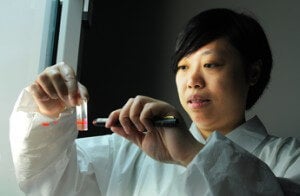What if checking for cancer was as easy as a pregnancy test?
Soon, it will be. Catching cancer early is the most crucial step to providing effective and proactive treatment against it. But most folks won’t undergo expensive and inconvenient testing until symptoms start to surface, and by then it could be too late. New advances in nanotechnology could change that, bringing an over-the-counter prostate cancer test kit to your pharmacy in the next few years.

Qun Huo, a chemist at the University of Central Florida, is leading a project to develop such a kit. She and her research team have created gold nanoparticles specially engineered to attach themselves to cancer-producing proteins in the body. The nanoparticles are placed in solution, and a drop of blood is added to the mix. If the cancerous proteins are present, the particles cluster around them and can be detected using a special light-scattering instrument.
Prostate cancer is the second most prevalent cancer among men in the US, effecting one in every six men. According to the American Cancer Society, there are 2 million men in the US with prostate cancer, and more than 27,000 die each year. Lots of cases go undetected in their early stages, largely because of the reluctance of men to get tested while they lack any symptoms.
Currently, prostate cancer is tested for using the Prostate-Specific Antigen (PSA) test. Huo’s nanoparticles attach to the exact same protein that the PSA tests for, but is much more accurate and sensitive to detecting that protein. It can also be used to detect a resurgence of cancer after surgery or chemotherapy has removed it. Perhaps most importantly, this new technology can help men avoid the daunting doctor’s visit to get a PSA and simply test themselves at home.
Huo’s cancer kit is preparing for clinical trials, which should take a few years. She estimates that an FDA-approved commercial product could hit your pharmacy within three to five years.
The most exciting part of Huo’s nanoparticles is that they can be engineered to attach to different types of proteins. Her current research is focused on prostate cancer, but reworking the structure of the nanoparticles will allow them to detect other types of cancer. Huo’s next plan is to focus on ovarian and breast cancer.
This technology is exciting because it brings the technology needed to detect disease down to a commercial level. Lots of people avoid the doctor’s office altogether out of inconvenience, fear, money, or some combination thereof. My own grandfather discovered his colon cancer late in the game, simply because doctors made him nervous. But putting diagnostic tools in the hands of the public can increase the chances of early detection, which drastically improves the likelihood that therapy will help.
Early testing is everywhere these days, from gender determinations to catching Alzheimer’s in its early stages. It’s amazing to think of how technology allows us to increasingly understand what’s happening in the body earlier and earlier. These kinds of tests, which cover a wide range of biological phenomena, are the product of creative innovations that hack the body and tell us about otherwise invisible conditions happening within. The Hub will continue to report on these kinds of research advances as they surface.



